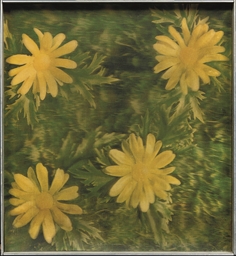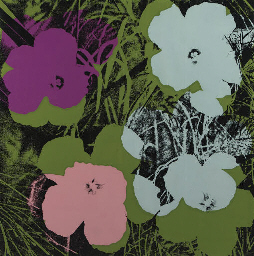Andy Warhol (American, 1928-1987) Flowers/A Portfolio of Ten Works, Suite of 10 screenprints 1970, edition of 250 plus proofs, printed by Aetna Silkscreen Productions, Inc., New York, published by Factory Additions, New York (Feldman & Schellmann, II.64-73). Each signed "Andy Warhol" on the reverse and numbered with stamp ".../250" on the reverse. Color screenprints on paper, sheet size 36 x 36 in. (91.4 x 91.4 cm), framed. Condition: A married suite, some with minor wear at corners and/or edges, most with soiling to verso, many with very subtle handling creases. Provenance: A private Massachusetts collection. N.B. Warhol took creatively acquired the image for his Flowers paintings and prints from the magazine Modern Photography. It had been shot by Patricia Caulfield, the magazine's executive editor, and published in the June 1964 issue. Caulfield had used the image in a fold-out spread, where multiple versions of the image demonstrated how a new Kodak home color processing system could be used to manipulate color photographs.1 This presentation would have instantly appealed to Warhol who ultimately re-used the image with countless color configurations, just as Caulfield had done in the magazine. The original image was rectangular and depicted seven hibiscus blossoms. Warhol cropped and manipulated it into a square composition of four blooms, even cutting, pasting, and rotating one of the blooms to a new position closer to three of its companions. The shift to a square composition allowed him to play with the composition's orientation. Warhol also varied the sizes and media of the composition, but always incorporated his screenprinting technique. An important aspect of Warhol's manipulation of Caulfield's image was to dramatically increase the contrast of the image. The result removed all shadows and highlights from the blossoms and turned the leaves and grasses beneath them into a flat pattern. Warhol's first show at the prestigious Leo Castelli Gallery opened in late November of 1964, and focused on the first Flowers paintings. David Bourdon, an art critic for the The Village Voice, described Warhol's Flowers saying, "The flowers appear to float against a murky background of waving green grass. They are like cut-out gouaches by Matisse set adrift on Monet's lily pond."2 We cannot help but tie the Flowers to the long history of floral still lifes as Bourdon did. At the same time, Warhol's perspective is utterly new. While the subject matter came from nature, the colors did not. They are Day-Glo, fluorescent, and neon. They are manufactured. The flattened, unmodelled blossoms only heighten the sense of their fabrication. The juxtaposition of manufactured nature is conspicuously ironic. Warhol is "…showing us mechanical ways of seeing and feeling… [but this is] concealed in blandness. These glossy, floral-patterned paintings look like printed oilcloth, plastic tablecloths, or…wallpaper.3 Even the "original" paintings employ screenprinting, heightening the sense of mechanization and mass-production. The publication of the Flowers portfolio in 1970 only strengthened the aspect of fabrication, especially when all ten are hung together. From a contextual perspective, the timing of the selection of the subject of flowers is interesting. It seems simplistic, and it is meant to. It comes just after his Disasters works of 1962-1963 and his ill-fated 1964 Thirteen Most Wanted Men to say nothing of the Marilyn and Jackie images - iconic figures of beauty associated with early and untimely deaths.4 This cannot help but connect the flowers to mortality and the funereal; to remind the viewer of the transient nature of flowers, youth, and life. This sense is completely undermined by the visual choices Warhol made. The colossal scale of these blooms seems anything but fragile and transient. Their high contrast makes the reproductive organs of stamen and pistil the only recognizable elements of these flowers.5 This reminds the viewer of the f
Andy Warhol (American, 1928-1987) Flowers/A Portfolio of Ten Works, Suite of 10 screenprints 1970, edition of 250 plus proofs, printed by Aetna Silkscreen Productions, Inc., New York, published by Factory Additions, New York (Feldman & Schellmann, II.64-73). Each signed "Andy Warhol" on the reverse and numbered with stamp ".../250" on the reverse. Color screenprints on paper, sheet size 36 x 36 in. (91.4 x 91.4 cm), framed. Condition: A married suite, some with minor wear at corners and/or edges, most with soiling to verso, many with very subtle handling creases. Provenance: A private Massachusetts collection. N.B. Warhol took creatively acquired the image for his Flowers paintings and prints from the magazine Modern Photography. It had been shot by Patricia Caulfield, the magazine's executive editor, and published in the June 1964 issue. Caulfield had used the image in a fold-out spread, where multiple versions of the image demonstrated how a new Kodak home color processing system could be used to manipulate color photographs.1 This presentation would have instantly appealed to Warhol who ultimately re-used the image with countless color configurations, just as Caulfield had done in the magazine. The original image was rectangular and depicted seven hibiscus blossoms. Warhol cropped and manipulated it into a square composition of four blooms, even cutting, pasting, and rotating one of the blooms to a new position closer to three of its companions. The shift to a square composition allowed him to play with the composition's orientation. Warhol also varied the sizes and media of the composition, but always incorporated his screenprinting technique. An important aspect of Warhol's manipulation of Caulfield's image was to dramatically increase the contrast of the image. The result removed all shadows and highlights from the blossoms and turned the leaves and grasses beneath them into a flat pattern. Warhol's first show at the prestigious Leo Castelli Gallery opened in late November of 1964, and focused on the first Flowers paintings. David Bourdon, an art critic for the The Village Voice, described Warhol's Flowers saying, "The flowers appear to float against a murky background of waving green grass. They are like cut-out gouaches by Matisse set adrift on Monet's lily pond."2 We cannot help but tie the Flowers to the long history of floral still lifes as Bourdon did. At the same time, Warhol's perspective is utterly new. While the subject matter came from nature, the colors did not. They are Day-Glo, fluorescent, and neon. They are manufactured. The flattened, unmodelled blossoms only heighten the sense of their fabrication. The juxtaposition of manufactured nature is conspicuously ironic. Warhol is "…showing us mechanical ways of seeing and feeling… [but this is] concealed in blandness. These glossy, floral-patterned paintings look like printed oilcloth, plastic tablecloths, or…wallpaper.3 Even the "original" paintings employ screenprinting, heightening the sense of mechanization and mass-production. The publication of the Flowers portfolio in 1970 only strengthened the aspect of fabrication, especially when all ten are hung together. From a contextual perspective, the timing of the selection of the subject of flowers is interesting. It seems simplistic, and it is meant to. It comes just after his Disasters works of 1962-1963 and his ill-fated 1964 Thirteen Most Wanted Men to say nothing of the Marilyn and Jackie images - iconic figures of beauty associated with early and untimely deaths.4 This cannot help but connect the flowers to mortality and the funereal; to remind the viewer of the transient nature of flowers, youth, and life. This sense is completely undermined by the visual choices Warhol made. The colossal scale of these blooms seems anything but fragile and transient. Their high contrast makes the reproductive organs of stamen and pistil the only recognizable elements of these flowers.5 This reminds the viewer of the f















Testen Sie LotSearch und seine Premium-Features 7 Tage - ohne Kosten!
Lassen Sie sich automatisch über neue Objekte in kommenden Auktionen benachrichtigen.
Suchauftrag anlegen